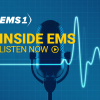EditorŌĆÖs note: Welcome to the What Paramedics Want podcast series of Inside EMS, sponsored by . The state of the industry What Paramedics Want Report explores issues tied to provider recruitment and retention; safety, health and wellness support; technology adoption; and career development, produced in partnership with Fitch & Associates and the National EMS Management Association. Learn more and download your copy.
In this episode of Inside EMS, our cohosts discuss how a lack of training feedback has led to an epidemic of providers not knowing the proper way to bag patients during ventilation, according to Kelly Grayson. He shares his new training plan for performance-focused ventilation and the tools heŌĆÖs implemented to make the procedure easier to master and understand.
Top takeaways
- Over-ventilation is an issue. Many EMS providers unknowingly over-ventilate patients during resuscitation, resulting in increased intrathoracic pressure and decreased coronary perfusion.
- Smaller BVMs can prevent over-ventilation. Using large BVMs, which deliver up to 1600 milliliters of air, leads to excessive tidal volumes far beyond the average adultŌĆÖs requirement of 500 milliliters. Switching to smaller-volume BVMs, such as pediatric bags for adult patients, can help prevent over-ventilation and improve patient outcomes.
- Real-time feedback improves ventilation. Devices like the provide real-time feedback on ventilation rate and volume, helping EMS providers learn proper ventilation techniques. GraysonŌĆÖs workshops utilizing these tools have demonstrated immediate improvement in the ability of providers to deliver the correct amount of air to patients.
Memorable quotes
- ŌĆ£When was the last time you actually got feedback on how good you were ventilating?ŌĆØ ŌĆō Kelly Grayson
- ŌĆ£Everything you thought you knew about bagging is probably wrong. And if you want to improve something you have to measure it. And if youŌĆÖre not measuring it, you donŌĆÖt know what needs improving or not.ŌĆØ ŌĆō Kelly Grayson
- ŌĆ£WeŌĆÖre under-ventilating the vast majority of our patients if weŌĆÖre only looking at chest rise.ŌĆØ ŌĆō Kelly Grayson
ABOUT THE SPONSOR
Whether replacing radio reports, alerting specialty teams, or managing mass casualty incidents, Pulsara simplifies communication. Pulsara scales to meet your dynamic communication needs. From routine patient alerts to managing large-scale emergencies, every responder and clinician connects seamlessly. Familiar yet powerful, Pulsara streamlines your response, from routine transfers to regional disasters. One tool. Every day. Regardless of event. Discover more at .
RATE & REVIEW
Catch a new episode of the Inside EMS podcast every Friday on , , , , , and .
Enjoying the show? Please take a moment to . Contact the Inside EMS team at theshow@ems1.com to share ideas, suggestions and feedback, or let us know if youŌĆÖd like to join us as a guest.












